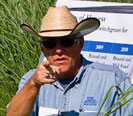
by Marvin Hall
Extension Forage Agronomist
Penn State University
After rain every other day during June and July, Pennsylvania has had nearly four weeks of excellent haymaking weather. High soil moisture at the beginning period of dry weather allowed forage crops to continue to grow into August when growth would have normally slowed. So, recent harvests have been high yielding and of good quality. Concern is now shifting to the long-term damage done to the plants and soil during earlier harvests when equipment shouldn’t have been on the wet soil.
Corn silage harvest has begun and yields are looking fantastic in well-drained areas of the state. However, on low lying or poorly drained fields, yields will probably be below normal.
Sorghum-sudangrass yields have been good due to adequate soil moisture and hot growing conditions.


Extension Forage Specialist
Recent (Aug 16, 2015) USDA Ag Statistics rate 78 percent of Kentucky pastures as good or very good and pasture ratings have been in the good to very good category throughout the summer. As mentioned in previous updates, the wet summer of 2015 has been great for Kentucky graziers, but has presented problems for producers trying to make high-quality hay (or any hay for that matter).
Fortunately, the first half of August has provided excellent haymaking weather. Average temperatures in the mid-80s along with low humidity and light winds have made it ideal to finish up second- or third-cutting hay crops (even some very late first cutting). These late cuttings will provide the quality required by cash hay producers, but supplies of high-quality hay demanded by dairies and horse owners may be tight this winter.
Hay supplies for cattle producers should be adequate going into the winter months, but it will be essential to have hay tested prior to feeding. A percentage of the late-cut and excessively rained-on hay will only be suitable for bedding. It is recommended that producers have questionable hay tested for aflatoxins before feeding.

Forage Extension Specialist
Montana State University
Timely summer rains have made for a great second cutting in some parts of Montana. However, smoky skies from fires all through the northwestern U.S. has made harvesting the final cut problematic in some areas. Producers have reported longer dry down times, some over 10 days, until baling. In eastern and central Montana, most producers harvested their only cut with minimal issues, although some yields were reported to be low. A lot of producers were forced to hay their cereal grains this year, and quite a few have reported fairly low protein values, falling to around 7 percent.
Nitrates continue to be an issue in cereal forages and warm-season grasses, particularly with the high temperatures and low amounts of precipitation. Producers are advised to test their forages prior to harvest and/or feedout to know whether their forage is at risk or not.
